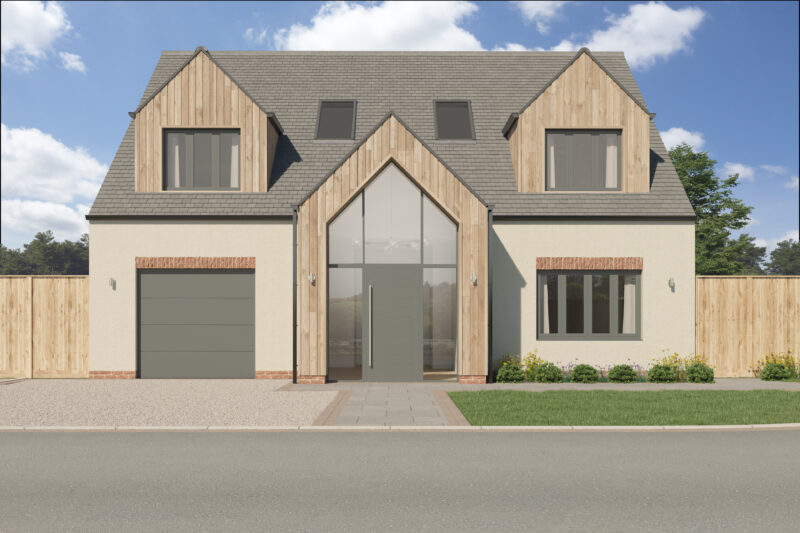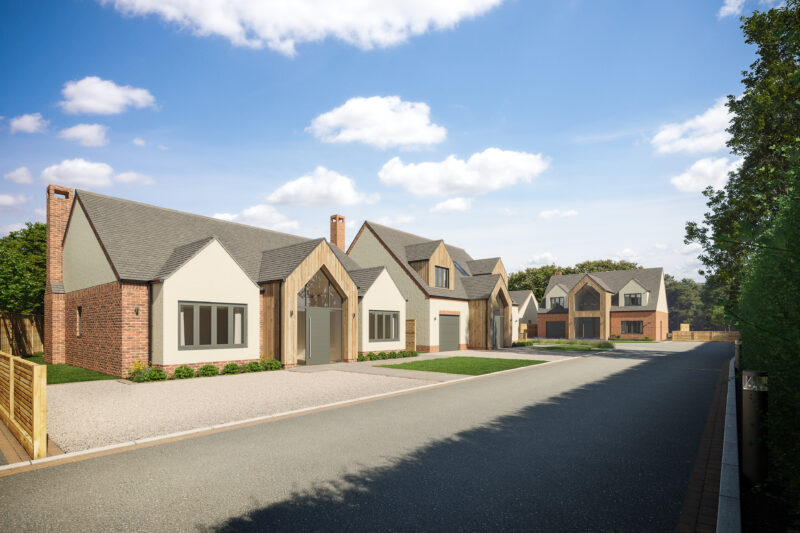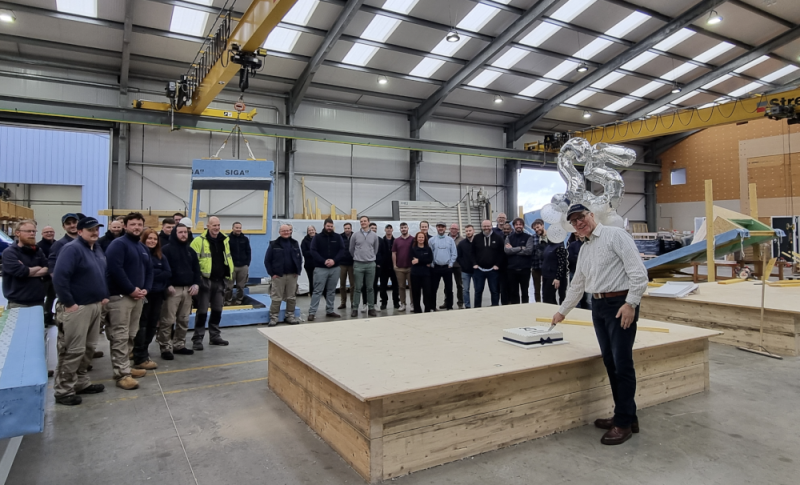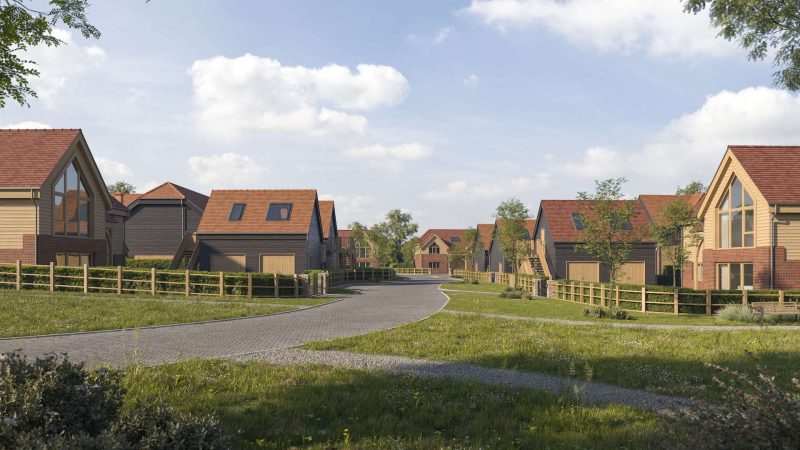NaCSBA Member Greenly Developments are proud to present a bespoke custom-build scheme of four plots. Greenly Developments offer the opportunity to have full design input, ensuring a home tailored to your personal tastes and lifestyle needs.
This development offers indicative designs ranging from 1250sqft bungalows to over 2000sqft dormer dwellings exclusive to Peachley Rise. Located in the picturesque village of Lower Broadheath Malvern Hills
The suggested open-plan design of these properties offer an open plan kitchen, dining, and living room area with a full-height glass gable and bi-folding doors. Vaulted ceilings in the kitchen-diner and bedroom areas create a sense of grandeur and openness, while the bi-fold doors allow for seamless indoor-outdoor living, bathing the space in natural light and offering uninterrupted views of the Worcestershire countryside.

The plots will be built to an exceptional standard and Greenly developments will manage all aspects of the build process. Options for premium finishes are prioritised. Kitchens by Elgar offer bespoke cabinetry and top-tier appliances, complemented by luxury flooring finishes that extend throughout the home.
Designed with sustainability in mind, the homes benefit from air source heat pumps and zoned underfloor heating, ensuring excellent eco credentials. These features contribute to energy efficiency, lower running costs, and a reduced environmental footprint.

Get in touch:
Contact Harts Homes on 01564 791111 or email info@harts-homes.co.uk to arrange a consultation or register your interest.
While energy efficient homes are gaining in popularity, many homeowners still wonder what they actually entail. Expert in the creation of high-performing, energy-efficient homes, Andy Mitchell, Managing Director at 21°, demystifies the concept. Good planning means you can secure the benefits and the best features that make these properties low energy, comfortable, healthy and sustainable.
Through practical elements like airtightness, thermal insulation, and efficient ventilation, Andy explains how energy-efficient homes are far more accessible than many people realise.
An energy-efficient home comprises three main pillars – minimal air leakage, effective ventilation, and a thermally-efficient core building shell (wall, roof, floor, windows, and doors) and connections between them. All of these elements must work together in synergy for optimal results.
In fact, these ‘optimal results’ provide a level of health and comfort that often far exceed what most people have experienced. It’s therefore essential these components are carefully considered as a whole system, rather than being viewed in silo, to guarantee their overall effectiveness.
For example, installing thermally-efficient windows and doors is not enough to foster a comfortable indoor temperature if there is uncontrolled air movement throughout the house.
Airtightness is crucial in preventing uncontrolled air leakage, which can lead to energy loss and increased heating costs. Airtightness is often overlooked, yet accounts for approximately 30-40% of a home’s heat loss. An airtight home helps to maintain a stable indoor temperature and improves energy efficiency.
From tapes and membranes to advanced sealing solutions, airtightness products are essential for creating a well-sealed building envelope.
These solutions should also extend to products such as windows and doors – where not only the frame is well-sealed to the building, but the opening element has gaskets that ensure an airtight seal when shut. Class 4 (BS EN 12207) is the best grade of airtightness for windows and doors These products prevent air leakage which can typically account for as much as a third of a home’s heat loss.
Effective ventilation is essential for maintaining indoor air quality and comfort while also being energy-efficient. Although making our homes airtight is key to improving efficiency, some air changes are still required to stop the moisture buildup. If this is not done correctly it can lead to mould and dust mite issues, as well as the accumulation of other toxic gases such as VOCs.
Mechanical ventilation with heat recovery (MVHR) systems are engineered to provide continuous fresh air while recovering heat from exhaust air, maintaining a comfortable indoor environment and alleviating the need for additional heating, further reducing energy consumption.
MVHR systems provide optimal ventilation, ensuring properties remain fresh and healthy – without compromising on energy efficiency.
For example, in addition to providing triple-glazed windows and doors, we designed and supplied the MVHR system in a new build Passivhaus home project, utilising a Zehnder ComfoAir Q MVHR unit with rigid steel ducting.
For this project 21° worked with oak frame specialists, Oakwrights (also a NaCSBA member), to develop an MVHR system that would work alongside the encapsulation system. The client cited the quality of the products and the precise installation as being “crucial for the airtightness of the project, ultimately contributing to the Passivhaus certification”.
The thermal efficiency of the building elements is integral to overall energy efficiency, reducing the need for artificial heating and cooling by maintaining a consistent indoor temperature. High-quality insulation materials and solutions ensure every part of the home, from walls and the roof to floors and the foundation, is well-insulated.
High-performance doors and triple-glazed windows are also an essential factor in a properly insulated property, as they’re designed to minimise heat transfer and ensure warm air stays in during the winter and out during the summer. Windows and doors should also contribute to the overall airtightness of the home, furthering energy efficiency.
A whole house retrofit in Cambridgeshire springs to mind in highlighting the role of windows and doors as part of wider thermal performance considerations. Here, our client chose inward opening windows, a lift and slide door, a fold-aside door, and two entrance doors (styles PA2 and GR1) from the GBS78 triple glazed timber range. The result was a comfortable, sustainable home that came as near as possible to Passivhaus standards.
At 21°, we believe that energy-efficient homes are not just for the eco-conscious few, but for everyone. By combining high-performance products with the right specifications and integration, homeowners can achieve remarkable energy savings, improved comfort, and a healthier living environment. Whether building a new property or retrofitting an existing one, solutions are available to meet the highest standards of energy efficiency and sustainability.
Energy-efficient homes are characterised by airtightness, thermally efficient building elements, and efficient ventilation, all working together to create a comfortable, healthy, and sustainable living space.
Through advanced construction techniques and technologies, energy-efficient homes are becoming more practical and accessible to all. As an industry leader, we are committed to advancing the knowledge and application of these solutions, helping to build a more sustainable future for all.
MEMBER UPDATE
NaCSBA member Oakwrights is celebrating a quarter of a century helping self builders create their dream oak-framed home. Specialising in green oak for homes, extensions and outbuildings, Oakwrights started with a team of six back in 1999.
Since then the firm has grown, providing perennially popular oak frame homes that marry traditional carpentry with modern technology and fabrication techniques.
Building in green oak, that is recently felled oak (up to 18 months), is a natural and historical building material that is capable of delivering in spades in terms of engineering strength and architectural detailing, as well as being sustainable as it is a natural carbon sink.
As well as having a show home, the Woodhouse, where clients can experience what it feels like inside an oak-frame home, the firm has gone on to build many self build homes, including turnkey homes, and now is involved with custom building on mult-plot sites. It’s received many awards from the industry press, both for the homes but also its systems, such as the 3i panel system. It recently celebrated winning its third award for Webbs Meadows (below), its custom build site, when it scooped The Daily Telegraph Homebuilding & Renovating Award for Best Custom Build 2023 in December.
Oakwrights also has plots available on its custom build sites, such as at Whipstocks and Webbs Meadow, Herefordshire
Below: Tim Crump, Founder of Oakrights, celebrates with the team

The National Self Build and Renovation Centre (NSBRC) in Swindon has launched a new event called Market Day, where many of its exhibitors will be encouraged to be on stand to chat to self builders in a relaxed and informal setting.
Kicking off on Friday 8 March, 10am-3pm, the Market Days will be on the second Friday of each month. The event is being organised following requests from visitors, to give people the chance to discuss projects in detail away from the busyness of the traditional show days.
Plus, visitors will be able to join a free guided tour of the NSBRC’s new-build educational zone at midday.
A list of exhibitors who will be on stand for the next upcoming Market Day is available on the NSBRC’s website, so you can plan you trip to speak to the right companies for your project.
Find out more about the NSBRC’s Market Days
The Right to Build Task Force has published new data that illustrates that not only are self build homes more sustainable than the average new build, but they have a greater beneficial local impact in terms of spend on materials and labour.
This is welcome news that adds weight to the case for a site when it is submitted for planning, contributing to the argument about a site’s impact versus its harm locally.
The National Custom and Self Build Association (NaCSBA) has long known anecdotally that individuals invest more in their own homes in terms of green tech and sustainable methods than mainstream builders, but welcomes the news that for the first time there is data-based evidence to support this.
In terms of building greener, this is mainly due to the fact that self builders invest more than a mainstream builder would as they want a home that’s more energy-efficient and in which they intend to live in for a long time. Equally, they don’t need to factor in a profit margin, unlike speculative builders.
NaCSBA also welcomes the news that the model contributes more locally than speculative building does, as it feeds into local economies – boosting SME businesses and offering training opportunities.
The analysis was conducted by Chamberlain Walker Economics, which used five local authority areas for the research, chosen as they represent a range of types and sizes. These were Breckland Council, Durham Council, Folkestone and Hythe District Council, Herefordshire Council and South Gloucestershire Council.
The Energy Performance Certificates (EPCs) of self build homes in the five areas were reviewed to compare energy usage, in comparison to new builds in these areas.
The research looked at two metrics: average energy consumption and average CO2 emissions. This found that the average energy consumption of custom and self build homes was significantly lower, by 8-42%, while CO2 emissions were also lower, by 7-43%, in comparison to new build local averages.
This adds to the growing evidence of custom and self build as a greener route to housing, such as the survey that showed that more than 50% of self builds have a renewable energy source as their primary heating system.
Using the same five areas, the research examined the economic factors around the local impact of labour and materials for custom and self build. It found that these homes roughly doubled the economic impact of mainstream housebuilding, as self builders buy more materials locally, and also source SME trades for their project.
This equated to self build spending nearly double, at £45 in every £100 spent, as opposed to mainstream housebuilders, who spend £22 on local materials and labour.
This is good news for local authorities, as well as providing a pool of work for SME housebuilders, a group that government is keen to see grow.
Analysis undertaken by the National and Custom and Self Build Association (NaCSBA) shows that there is an at least 64% under-measuring of demand by the Right to Build registers.
The analysis, published in the industry-focused Custom and Self Build Report 2023/24, took a fresh look at the registers, which every local or planning authority in England must host, as set out by the Right to Build legislation (Self and Custom Housebuilding Act 2015).
Looking at a three year period (2019-2022), it found that 83,430 people were interested in pursuing an owner-commissioned home, in comparison to the 29,697 people who had signed up to a local authority register for the same three year period. This shows that the demand reflected by these registers is underestimated by at least two thirds.
For the purpose of the analysis NaCSBA reviewed the postcode data of people interested in custom and self building and compared this data against total numbers who had signed a register. It marked interest as those people who had invested roughly £40 on either a magazine subscription or in attending a self build show, with the associated costs for the entire day. For this it assessed anonymised data from three of NaCSBA’s Gold Partners, Build It, Homebuilding & Renovating and the National Self Build and Renovation Centre (NSBRC).
The Right to Build registers are the go-to source of demand data for local authorities that acts as evidence of those people who want to build locally. This is important evidence that has a positive input into the decision making process around whether a site gets planning – or not.
NaCSBA is aware that there are many frustrations for people around the registers, such as local connection test or a joining fee, which can discourage people from signing, but strongly advises anyone wanting to self build to sign their register.
This is because the registers are starting to feed into appeals that are leading to companies being awarded planning permission for self build sites, when they were originally turned down, as well as contributing to more supportive local policy to emerge to help meet this demand.
However, local authorities should also be considering secondary sources of data for evidencing demand, such as the multiple effect that the registers underestimate demand – as shown by this research. This helps create a fuller picture of local demand.
Callum Park Lower Halstow, Kent is a collection of nine plots offering anyone wanting to build a custom build option, with the plots purchased at ‘Golden Brick’. There are five remaining plots and you can find out more on an open day on Saturday 27 January, 11am, when you can visit the site and find out more about the route.
The site is enabled by NaCSBA member Custom Build Homes (CB) on this former equine centre, in partnership with a local development company Masters Knowles Developments.
Overlooking the River Medway and with great transport links to London the site features custom build homes where buyers have a choice of configurations and designs, as agreed in the planning permission. Once tailored to the buyer’s preferences, the homes will be built out by the developer on their behalf as a ‘Blank Canvas’, ready for the owner to complete.
This model is great for first timers to self build, as much of the hard work connected with the big decision has already been done, and homes are handed over as a plastered and painted shell.
The remaining plots start from £458,000, with discounts available on legal fees for reservations before 10 February. Plots are purchased at ‘Golden Brick’, with the foundations and services in place – a mechanism that offers significant self build savings.
Custom Build Homes helps buyers finish their build through its unique ‘My Custom Build’ App, a digital platform to support the design and fit out of the internal spaces – the kitchens, bathrooms, flooring and decorations. The App also links buyers up with some local trades and vendors to streamline the process.

Find and sign Swale’s Self Build Register